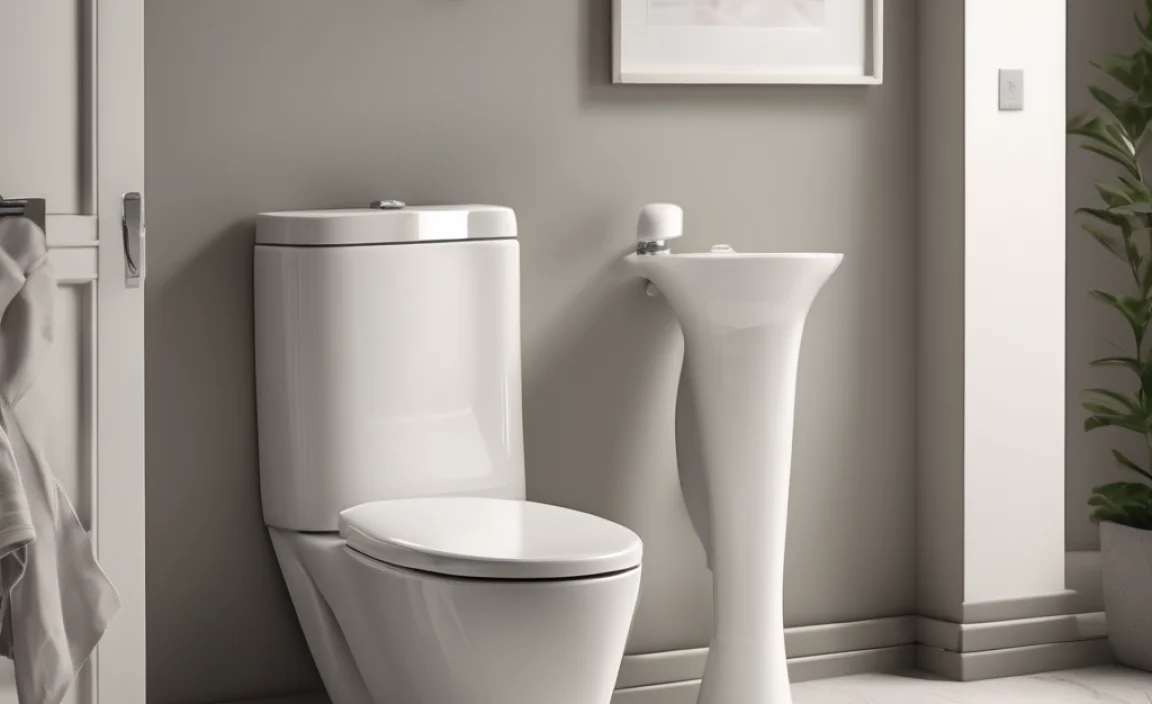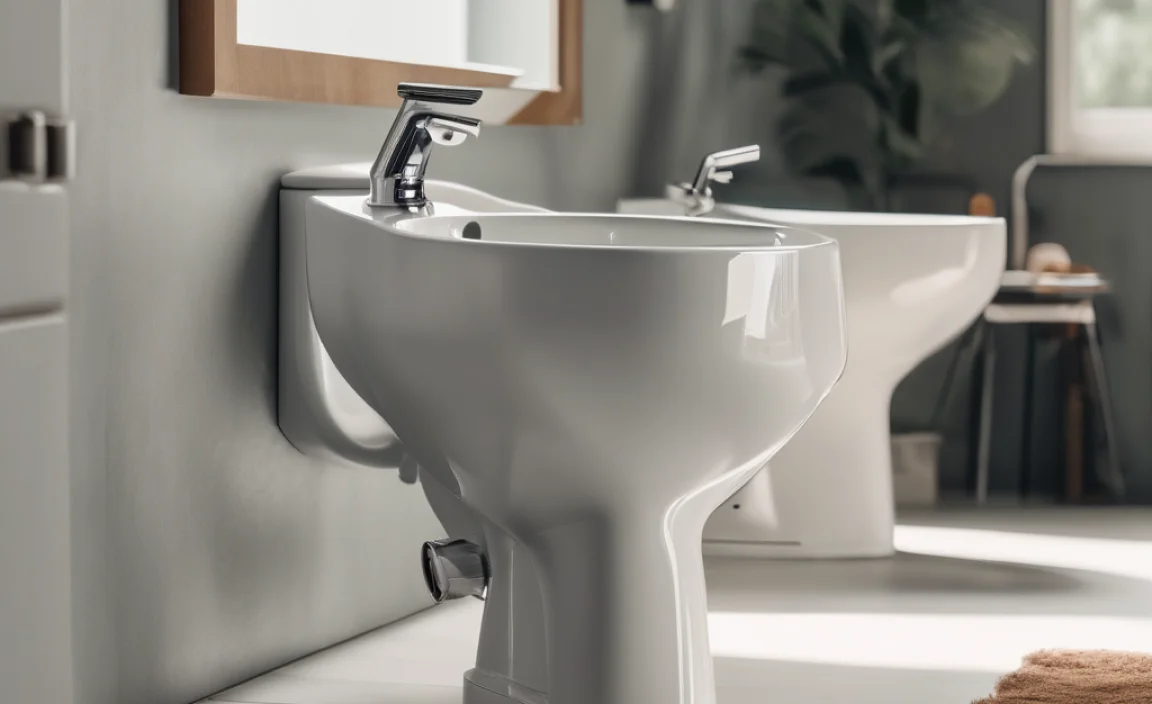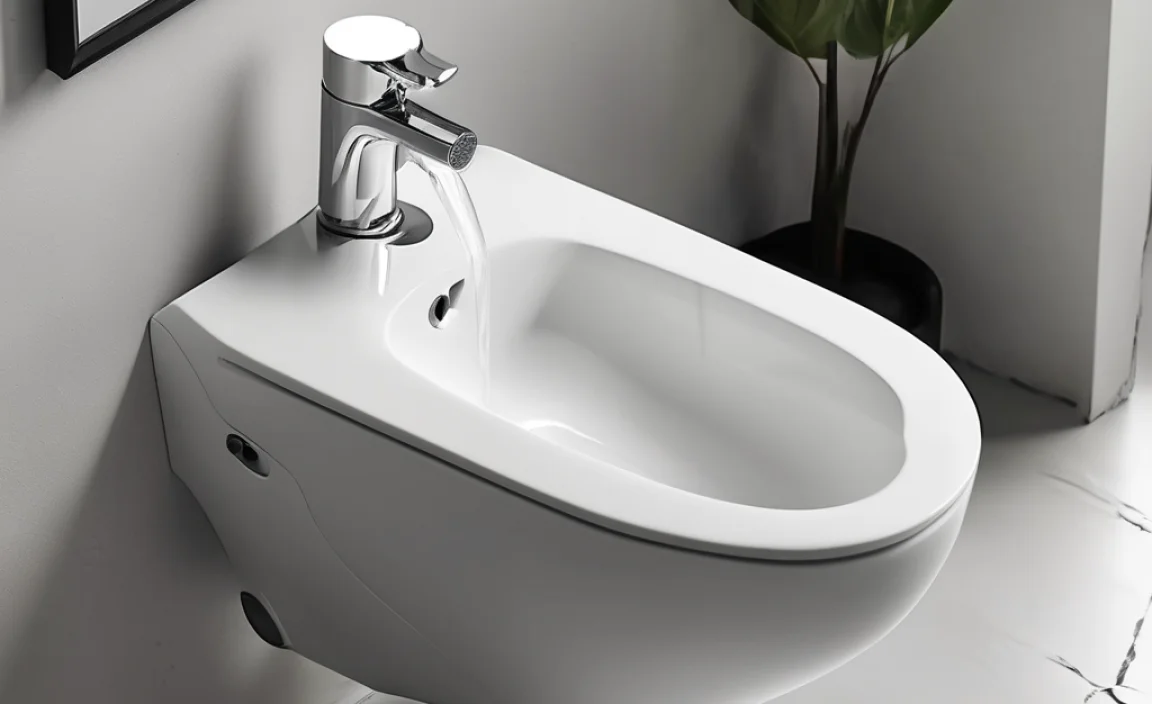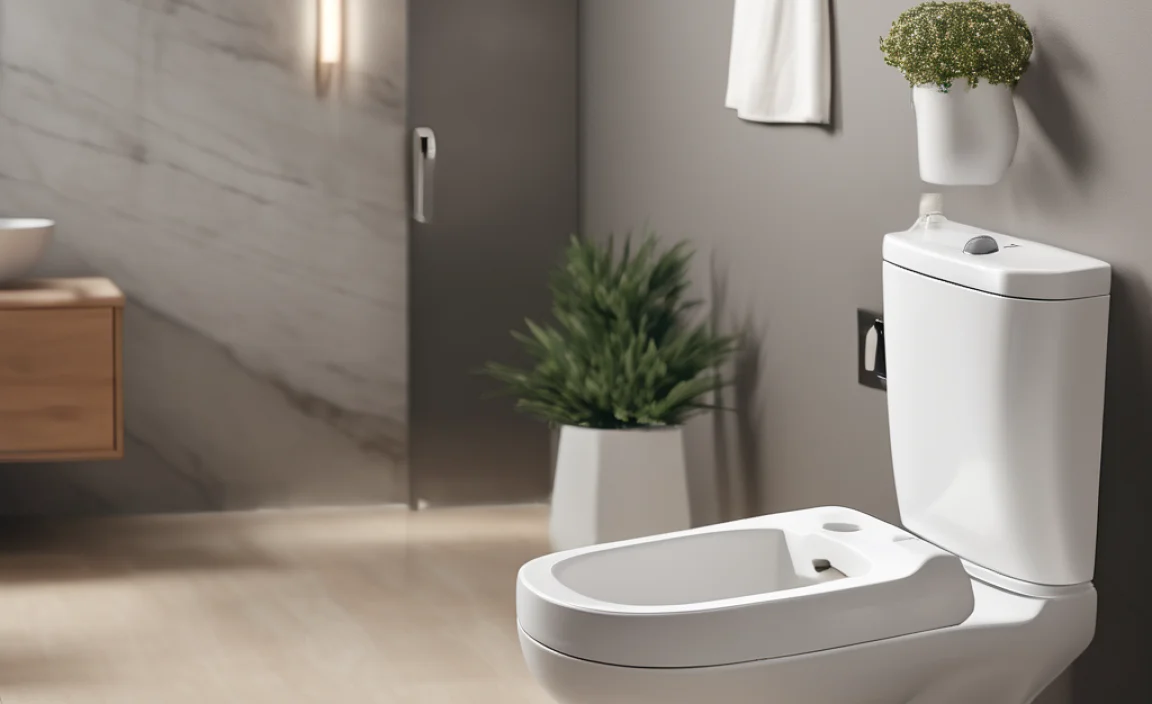Quick Summary:
Want to know how a bidet works? It’s simpler than you think! Bidets use a stream of water to clean you after using the toilet, offering a more hygienic and eco-friendly alternative to toilet paper. Some bidets attach to your existing toilet, while others are standalone units. They all work by directing a stream of water to cleanse your bottom, leaving you feeling fresh and clean. Many offer adjustable water pressure and temperature for maximum comfort.
Ever wondered about bidets? They seem fancy, maybe even a bit intimidating. But they’re actually quite simple and incredibly effective for personal hygiene. Many people find them much cleaner and more comfortable than traditional toilet paper. Plus, they’re good for the environment!
If you’re curious about how these devices work, you’re in the right place. We’ll break down the whole process, step by step. You’ll learn about the different types of bidets, how they’re installed, and exactly how they deliver that refreshing clean. Get ready to discover a new level of bathroom hygiene!
Understanding the Basics of Bidets

Before diving into the mechanics, let’s cover what a bidet actually is. A bidet is a bathroom fixture designed to clean your nether regions with a stream of water after you use the toilet. It’s a common fixture in many parts of the world and is gaining popularity in North America for its hygiene and environmental benefits.
Types of Bidets
There are several types of bidets, each with its own installation and functionality.
- Bidet Toilet Seats: These replace your existing toilet seat and attach to the toilet’s water supply. They often include features like heated seats, warm air dryers, and adjustable water pressure.
- Bidet Attachments: These are simple devices that attach to your existing toilet and connect to the water supply. They’re a more affordable option and easy to install.
- Standalone Bidets: These are separate fixtures next to the toilet. You use the toilet first, then move to the bidet for cleaning.
- Handheld Bidets (Bidet Sprayers): These are handheld sprayers connected to the toilet’s water supply. They offer a manual approach to cleaning.
Key Components of a Bidet
While the specific components vary depending on the type of bidet, here are the common parts:
- Nozzle: This is the part that delivers the water stream. Some bidets have multiple nozzles for different cleaning functions.
- Water Supply Connection: This connects the bidet to your home’s water supply.
- Control Panel: This allows you to adjust the water pressure, temperature, and nozzle position.
- Dryer (Optional): Some bidets include a warm air dryer to eliminate the need for toilet paper.
- Seat Warmer (Optional): Many bidet toilet seats come with a heated seat for added comfort.
How a Bidet Works: A Step-by-Step Guide

Now, let’s get into the nitty-gritty of how a bidet actually works. Whether you have a bidet seat, attachment, or standalone unit, the basic principles are the same.
Step 1: Using the Toilet
First, use the toilet as you normally would. This is the same regardless of the type of bidet you have.
Step 2: Activating the Bidet
This is where the bidet takes over. The activation method depends on the type of bidet.
- Bidet Toilet Seats: Use the control panel (usually located on the side of the seat or a remote control) to select your desired cleaning function.
- Bidet Attachments: Turn the control knob to activate the water stream.
- Standalone Bidets: Position yourself over the bidet and use the faucet controls to adjust the water temperature and pressure.
- Handheld Bidets: Aim the sprayer and gently squeeze the handle to release the water.
Step 3: Adjusting Water Pressure and Temperature
Most bidets allow you to adjust the water pressure and temperature for a comfortable cleaning experience. Start with a low pressure and gradually increase it to your liking. Similarly, adjust the water temperature to a comfortable level.
Step 4: Positioning the Nozzle
Many bidet seats have adjustable nozzles that can be positioned for optimal cleaning. Use the control panel to adjust the nozzle position until you find the most comfortable and effective setting. Some bidets also have a pulsating or oscillating spray function for a more thorough clean.
Step 5: Cleaning
The bidet will spray a stream of water to clean your bottom. Allow the water to cleanse the area thoroughly. This usually takes about 20-60 seconds, depending on your preference.
Step 6: Drying
After cleaning, you have a few options for drying.
- Warm Air Dryer: If your bidet has a warm air dryer, activate it to dry the area. This may take a few minutes.
- Toilet Paper: You can use a small amount of toilet paper to pat yourself dry. Since you’ve already cleaned with water, you’ll use significantly less toilet paper than usual.
- Towel: Some people prefer to use a dedicated towel to dry themselves after using the bidet.
Step 7: Cleaning the Bidet
To keep your bidet clean and hygienic, wipe down the nozzle and seat regularly with a damp cloth and mild soap. Some bidets have a self-cleaning function that automatically cleans the nozzle after each use.
The Benefits of Using a Bidet

Bidets offer numerous benefits that make them a worthwhile addition to any bathroom.
Improved Hygiene
Bidets provide a more thorough cleaning experience than toilet paper alone. Water effectively removes bacteria and waste, reducing the risk of infections and irritation.
Environmental Friendliness
By reducing or eliminating the need for toilet paper, bidets help conserve trees and reduce waste. The production of toilet paper requires a significant amount of water and energy, so using a bidet is a more sustainable choice.
Cost Savings
While the initial cost of a bidet may seem high, it can save you money in the long run by reducing your toilet paper consumption. Over time, the savings can add up significantly.
Comfort and Convenience
Many people find bidets more comfortable and convenient than toilet paper. The adjustable water pressure and temperature allow for a personalized cleaning experience. Bidets can also be particularly helpful for people with mobility issues or certain medical conditions.
Reducing Plumbing Issues
Less toilet paper usage can also reduce the risk of clogged pipes and plumbing issues. Toilet paper, especially thicker varieties, doesn’t always break down easily and can cause blockages in your plumbing system. Using a bidet minimizes this risk.
Choosing the Right Bidet for You

With so many different types of bidets available, it’s important to choose one that meets your needs and budget. Here are some factors to consider:
Budget
Bidets range in price from affordable attachments to high-end toilet seats with all the bells and whistles. Determine how much you’re willing to spend before you start shopping.
Features
Consider which features are most important to you. Do you want a heated seat, warm air dryer, adjustable nozzle position, or pulsating spray? Prioritize the features that will enhance your cleaning experience.
Installation
Some bidets are easier to install than others. Bidet attachments are typically the easiest to install, while bidet toilet seats may require more plumbing knowledge. If you’re not comfortable with DIY projects, consider hiring a plumber to install your bidet.
Space
If you have a small bathroom, a bidet attachment or bidet toilet seat may be a better option than a standalone bidet. Consider the available space in your bathroom and choose a bidet that fits comfortably.
User Reviews
Read online reviews to get an idea of the quality and performance of different bidets. Pay attention to reviews that mention ease of use, durability, and customer support.
Installing a Bidet Attachment: A Simple Guide

For many, a bidet attachment is the easiest and most affordable way to get started. Here’s a simplified guide to installing one:
Tools You’ll Need
- Adjustable wrench
- Screwdriver
- Plumber’s tape (Teflon tape)
- Bucket or towel (to catch any water drips)
Step-by-Step Instructions
- Turn Off the Water Supply: Locate the shut-off valve behind your toilet and turn it clockwise to shut off the water supply.
- Flush the Toilet: Flush the toilet to empty the tank. This will prevent water from spilling during the installation process.
- Disconnect the Water Supply Hose: Use the adjustable wrench to disconnect the water supply hose from the bottom of the toilet tank. Have a bucket or towel ready to catch any remaining water.
- Install the T-Adapter: Attach the T-adapter to the bottom of the toilet tank where you disconnected the water supply hose. Make sure to wrap the threads of the T-adapter with plumber’s tape to prevent leaks.
- Connect the Water Supply Hose to the T-Adapter: Reconnect the water supply hose to the bottom of the T-adapter. Tighten the connection with the adjustable wrench.
- Attach the Bidet Attachment: Place the bidet attachment onto your toilet bowl, aligning it with the mounting holes. Secure the attachment with the screws provided.
- Connect the Bidet Hose: Connect the bidet hose to the T-adapter and the bidet attachment. Tighten the connections with the adjustable wrench.
- Turn On the Water Supply: Slowly turn the shut-off valve counterclockwise to turn on the water supply. Check for leaks at all connections. Tighten any connections that are leaking.
- Test the Bidet: Test the bidet to make sure it is working properly. Adjust the water pressure and nozzle position to your liking.
Important Safety Tip: Always double-check that all connections are tight to prevent leaks. If you’re not comfortable with any part of the installation process, consult a professional plumber.
Maintaining Your Bidet
Regular maintenance will keep your bidet working efficiently and extend its lifespan.
Cleaning the Nozzle
Clean the nozzle regularly to prevent buildup and ensure a clean spray. Many bidets have a self-cleaning function, but you can also clean the nozzle manually with a soft brush and mild soap.
Wiping Down the Seat and Controls
Wipe down the seat and controls with a damp cloth and mild soap to keep them clean and hygienic. Avoid using harsh chemicals or abrasive cleaners, as they can damage the bidet’s surface.
Checking for Leaks
Periodically check for leaks at all connections. If you notice any leaks, tighten the connections with an adjustable wrench. If the leaks persist, you may need to replace the water supply hose or T-adapter.
Replacing Filters
Some bidets have filters that need to be replaced periodically. Check the manufacturer’s instructions for the recommended filter replacement schedule.
Troubleshooting Common Bidet Problems
Even with proper maintenance, you may encounter some common bidet problems. Here are some troubleshooting tips:
| Problem | Possible Cause | Solution |
|---|---|---|
| No Water Spray | Water supply is turned off. | Check that the water supply valve is turned on. |
| Weak Water Spray | Low water pressure. | Check your home’s water pressure. Clean the bidet nozzle. |
| Leaking Connections | Loose connections. | Tighten the connections with an adjustable wrench. |
| Nozzle Not Extending | Nozzle is blocked. | Clean the nozzle with a soft brush. |
| Strange Noises | Internal component issue. | Consult the manufacturer’s manual or contact customer support. |
Bidet Safety Tips
While bidets are generally safe, it’s important to follow these safety tips:
- Use Proper Water Pressure: Start with low water pressure and gradually increase it to avoid discomfort or injury.
- Maintain Hygiene: Clean the bidet regularly to prevent the growth of bacteria.
- Avoid Harsh Chemicals: Use mild soap and water to clean the bidet. Avoid harsh chemicals or abrasive cleaners.
- Consult a Professional: If you’re not comfortable with the installation or maintenance process, consult a professional plumber.
FAQ About Bidets
What exactly does a bidet do?
A bidet uses a stream of water to clean your bottom after you use the toilet. It’s a more hygienic way to clean compared to just using toilet paper.
Are bidets sanitary?
Yes! Bidets are very sanitary. They use fresh water to clean, which removes bacteria and waste more effectively than toilet paper.
Do bidets use warm water?
Some bidets do! Many bidet seats and attachments offer both warm and cool water options, so you can adjust the temperature to your comfort.
Is it hard to install a bidet?
Not usually. Many bidet attachments are designed for easy DIY installation and can be set up in under an hour with just a few simple tools.
Will a bidet fit my existing toilet?
Most bidet attachments and seats are designed to fit standard toilet sizes. However, it’s always a good idea to check the measurements to ensure a good fit.
Are bidets expensive to operate?
Bidets are quite affordable to operate. They use a small amount of water and electricity (for models with heated seats or dryers), so the cost is minimal.
Do I still need toilet paper with a bidet?
You’ll use much less toilet paper! Many people use just a small amount to pat dry after using the bidet, which is much more eco-friendly.
Conclusion
So, how does a bidet work? As you’ve seen, it’s a simple yet effective way to improve your personal hygiene, reduce your environmental impact, and save money on toilet paper. From understanding the different types of bidets to installing and maintaining them, you now have the knowledge to make an informed decision about adding one to your bathroom.
Whether you opt for a basic bidet attachment or a high-end bidet toilet seat, you’ll likely find that the benefits outweigh the initial investment. With adjustable water pressure, temperature controls, and even warm air dryers, bidets offer a level of comfort and cleanliness that toilet paper simply can’t match.
So go ahead, explore the world of bidets and discover a cleaner, greener, and more comfortable way to take care of business! Your bottom (and the planet) will thank you.


